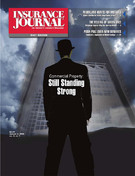The commercial property market took a huge hit from four major hurricanes that struck the U.S. mainland this past year. The full effects may have yet to be felt, however, it looks like commercial property insurers came through in solid shape considering the magnitude of the storms.
That’s not to say that the commercial property insurance industry is free of worry as it heads into 2005. That’s not the case–its concerns in the new year include the prospect of new hurricanes, a potential lapse in terrorism protection for insurers, increasing risks for businesses with overseas operations, and the inevitability of an accumulation of “ordinary catastrophes” that may fly under the radar but add up in the loss column.
Although commercial property rates fell in 2004, whether this trend will continue as the hurricane numbers pile up and the other unknowns become known could vary by state or region.
Weathering the storms
According to a report by Standard & Poor’s titled “U.S. Commercial Lines Year-End 2004 Outlook: Rate Cuts and Intensifying Investigations Squeeze Earnings,” insurers learned a valuable lesson from Hurricane Andrew’s devastation in 1992. Afterwards, companies adopted sophisticated modeling tools to better control such risks. For this reason, the 2004 hurricanes did not cause any ratings action against U.S. commercial property/casualty insurance companies.
“They had the impact that you would expect,” said Robert Hartwig, senior vice president and chief economist for the Insurance Information Institute. “Commercial property coverage rates were falling nationally through 2004. The hurricanes put a damper on that in the Southeast. So the effect was mostly limited to that area. There was a notable moderation in the decline in the Southeast, and in some areas there they had an increase.”
According to the ISO, estimated insured commercial property losses for 2004 Hurricanes Charley, Frances, Ivan and Jeanne totaled approximately $6.329 billion. Commercial property losses for were as follows: Charley, $2.712 billion; Frances, $1.375 billion; Ivan, $1.503 billion; and Jeanne, $739 million. Despite the massive blow to the industry, commercial property insurers have held strong.
“I believe carriers were well prepared for them (the hurricanes),” said Ken Schreiber, senior vice president for HUB International Northeast, who writes mostly commercial real estate in the New York tri-state area. “We’re seeing higher rates in Florida–and it’s harder to get the capacity there–but it’s available. I don’t expect it to impact the overall property market nationwide.”
“In 2004, we saw a dramatic softening and expect it to continue in 2005. We are also seeing some carriers coming out with increased capacity now. I would expect to see more carriers aggressively go after property in 2005 with more capacity,” Schreiber added.
“It’s a little spotty right now,” said Tom Upton, a director with Standard & Poor’s. “About a year ago, commercial property was the first line to see softening in pricing. That continued, for the most part, through 2004. Although on a localized basis, particularly in Florida due to the multiple hurricane events, there was some hardening. But the overall trend is clearly a softening as rates are declining.”
“In the rest of the country, the market conditions favor the buyer,” Hartwig said. “The price of commercial property coverage is falling for the majority of today’s businesses outside the Southeast. And that may continue well into 2005.”
Commercial property prices may be falling, except for coastal properties.
“The major property issues are along the Gulf of Mexico and the Atlantic Coast. Insurers will be very cautious about underwriting coastal properties there. The cost of which could be higher,” Hartwig said. “Insurers will be interested in the quality of building standards, particularly with new construction. If some properties are constructed on land prone to flooding or some other form of destruction, insurers may shy away from them.”
One expert cautioned that the industry might see a delayed reaction to the deadly hurricanes.
“As carriers digest the full impact of their losses, it may (affect pricing),” said George Stratts, senior vice president for Lexington Insurance Company. “Cats have a way of developing over time. And the true loss experience of those cats, develop over time. What may have been originally perceived in September or October may not be the actual result that gets realized in March or April.”
Upton, who contributed to the aforementioned Standard & Poor’s report, maintained that there was one major reason commercial property and casualty writers didn’t take a bigger hit from the hurricanes. “Commercial lines companies used property and catastrophe reinsurance to a great extent,” Upton explained.
Beware this time around
While most expect commercial property prices to keep trending downward, they don’t anticipate a repeat of what occurred during the last soft market.
“We think that we’ll probably see better discipline in the market this time than during the last downturn in the pricing cycle,” Upton said.
“Carriers will be very competitive on rate–and they will give reductions–if the risk is running well, it’s properly protected, and good construction,” Schreiber said. “We’re not seeing the craziness we saw in the 1990s when they were writing substandard buildings for rates that should be applied to HPR construction. If it’s a good building, you will see aggressive markets out there fighting for the business. I’m predicting at least another 10 percent decrease for 2005.”
“We’re not predicting that they’ll be cut-throat competition, but we’re still expecting prices to decline,” Upton added.
Regional ‘ordinary cats’
While hurricanes took center stage this past year, many different natural disasters can lead to major losses. The state of the commercial property market also hinges on the so-called “ordinary catastrophes” that hit every region of the country. Many of them fail to make national headlines but they do seriously and over time impact loss ratios.
Stratts pointed out how the nation endured its largest windstorm season ever in 2004.
III’s Hartwig noted that tornadoes, hail storms and, in rarer instances, earthquakes cause significant commercial property damage.
While every area of the country faces the risk from some form of catastrophe, Hartwig had no problem identifying the most susceptible region. “Easily the Southeast, when you put everything together,” he said.
He identified the Upper Midwest–the Dakotas and Minnesota–as the area that gets affected the least by natural disasters. “The people there know that it’s going to get cold and snow, so they’re prepared for it. And they don’t have much catastrophic exposure–there’s no coastline and it’s not seismically active. You have a possible situation with tornadoes and hail, but it’s not in tornado or hail alley.”
“If you poll small business owners, the number one reason that they have to close because of natural disasters is severe winter storms,” Hartwig said. “In some cases, there might be an insurance loss; in most cases there won’t be.”
Sometimes it’s not the property coverage that is triggered for the loss from an ordinary cat storm, flood or other act of nature.
“People think about the destruction that they see on TV. But in some major disasters the business interruption costs are actually higher,” Hartwig said. “Business interruption losses from 9/11 were actually larger than the losses associated with the destruction of the World Trade Center property itself.”
TRIA and the marketplace
Beyond natural catastrophes–major and ordinary–there are manmade catastrophes for the industry to worry about. Viewpoints differ on the impact the federal Terrorism Risk Insurance Act and the failure of Congress thus far to renew it past its Dec. 31, 2005, expiration date, will have on the commercial property market.
“In the short term, it’s creating a lot of uncertainty, specifically for those carriers who depend most heavily on the government backstop for the limits that they’re providing in the marketplace,” said Jim Maden, assistant vice president, property for Lexington Insurance Company.
TRIA created a three-year federal “back stop” reinsurance up to an aggregate limit of $100 billion, and required insurers to make TRIA coverage available to all commercial policyholders.
“So we see signs of some uncertainty out there as to the capacity that might be available post-Dec. 31, 2005, when the backstop expires,” Maden said.
“The effect on most writers of commercial property insurance will be that they’ll have terrorism excluded from their policies,” Upton said. “So the effect on them will be fairly minimal, they’ll just exclude the coverage. The effect will be felt by property owners that will want to have that coverage and won’t find it available.”
The new reality
Post-Sept. 11, a new reality was created for the insurance industry and its commercial property insureds. Businesses worldwide face a new set of issues in managing the broad spectrum of risks.
According to a recent study released by Aon, 57 percent of companies studied have decided to “take up” some kind of terrorism insurance–an increase over the 24 percent found earlier this year.
“It should come as no surprise to the industry that the coverage offered through TRIA has become increasingly desirable for business,” said Gary Marchitello, managing director in Aon’s National Property Syndication group in New York. “With the possible expiration of TRIA, Capitol Hill and the insurance industry cannot afford to postpone efforts to renew TRIA or create a similar mechanism to manage the global terror risks the ‘new reality’ has created.”
The study states: “TRIA’s importance as a backstop cannot be overstated. Its expiration will cause an immediate and significant diminution of the available supply of terrorism capacity that is likely to leave the market hard pressed, if not unable, to meet the potential demand for risk transfer capacity.”
Schreiber expects rates to continue softening amid TRIA’s uncertainty, except in areas believed at higher risk for terrorism. “In TRIA-heavy areas like New York City or Washington, D.C., real estate, you’ll have to pay significantly more for it. You may see carriers revert back to pre-TRIA, where they would pull out–or pull back–from areas where they can’t exclude the coverage.”
While it doesn’t appear that the terrorism threat is going away anytime soon, it is possible the perception of the risk among underwriters could diminish with time. “It could eventually happen that the mindset of the industry at large changes to the point where they don’t think terrorism is such a great risk anymore. Then they’ll stop excluding it. But I don’t think that’s the mindset right now,” Upton ventured.
Insurers might relax if they knew for certain that TRIA would get extended beyond year-end 2005, but they don’t know that for sure right now.
Anything can happen
Schreiber knows that anything can happen this year. “There are the two big trends–softening and more capacity, which also lends itself to the rates coming down. But things can change, because who knows what affect TRIA will have on that.”
“In general, right now there is a level of uncertainty in the marketplace,” agreed Stratts.
Lower prices may create some secondary trends. Insureds may look to apply their premium savings elsewhere, according to Schreiber. “You may see people consider taking lower deductibles with the prices coming down. Whereas, when the market got hard, they went with higher deductibles. I haven’t seen a lot of that yet, but we may as prices continue to drop.”
While lower premiums create opportunities for brokers and independent agents, they also present an additional challenge for insurance companies. As stated in S&P’s year-end report: “Even if insurers remain quite profitable, the fact is that rates are softening, which will place sustained downward pressure on earnings.”
Topics Catastrophe USA Carriers Profit Loss Commercial Lines New York Business Insurance Property Hurricane Market
Was this article valuable?
Here are more articles you may enjoy.


 Swiss Re Shares Drop After New Profit Target Falls Short of Expectations
Swiss Re Shares Drop After New Profit Target Falls Short of Expectations  In Alabama, Shot Employee Gets No Workers’ Comp and No Employer’s Liability
In Alabama, Shot Employee Gets No Workers’ Comp and No Employer’s Liability  Lawsuit Over Burger King’s Whopper Ads Set Back by Federal Judge
Lawsuit Over Burger King’s Whopper Ads Set Back by Federal Judge  Viewpoint: Agentic AI Is Coming to Insurance Industry – Much Faster Than You Think
Viewpoint: Agentic AI Is Coming to Insurance Industry – Much Faster Than You Think 


